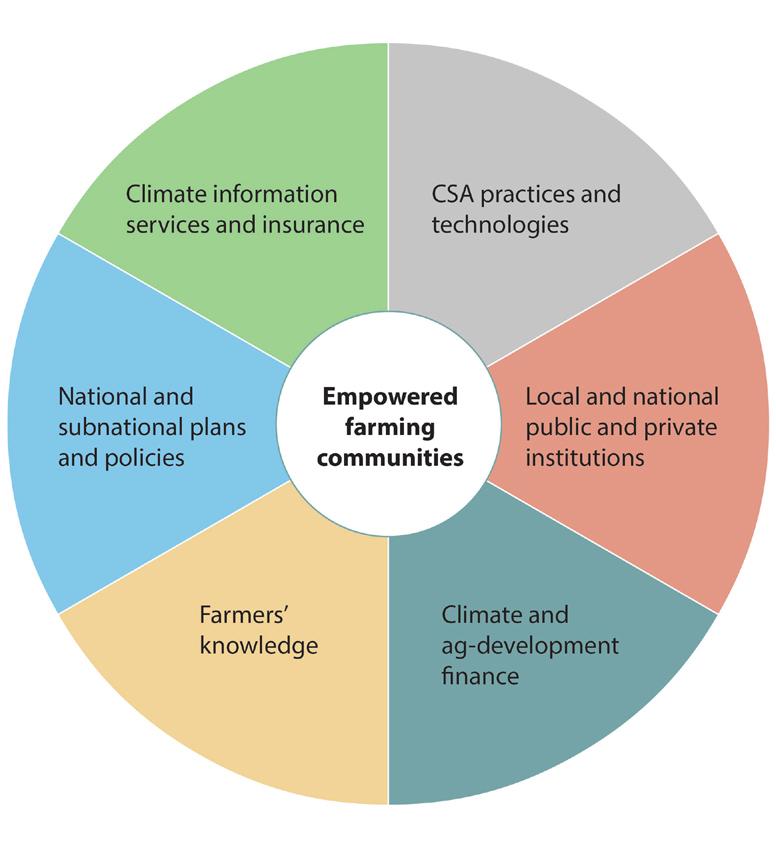A recent paper delineates the Climate-Smart Village approach as an integrative strategy for scaling up adaptation options in agriculture

With early results from Asia, Africa and Latin America, the different examples of Climate-Smart Villages illustrate the high potential for scaling out promising climate-smart agricultural technologies, practices and services in climatic risk prone areas.
The bridge between food security as a concept and as reality for millions of people remains wide despite increases in global food production. With almost 800 million people having insufficient food, the situation is only exacerbated by climatic impacts over food production. Studies have recurrently shown how food production will continue to be impacted due to climate-induced challenges.
However, the availability of various options for reducing the negative impacts of climate change at our disposal opens up a platform for testing, evaluating and assessing the best options and practices to help build up resilience and also reduce emissions from the agricultural sector. Climate-smart agriculture (CSA) in this situation emerges as the method and practice for increasing sustainable agricultural production by adaptation to climatic changes and thereby enhance resilience.
Agricultural research for development
In a recent paper titled ‘The climate-smart village approach: framework of an integrative strategy for scaling up adaptation options in agriculture’ by researchers from the CGIAR Research Program on Climate Change, Agriculture and Food Security (CCAFS), a process of resilience building with CSA interventions through the Climate-Smart Village (CSV) approach was elaborated with early results from Asia, Africa and Latin America.
At the outset, the paper emphasizes that despite several successful CSA programs on board, there is still a weak uptake of the same by farming communities. One of the critical reasons for this is the lack of evidence at the disposal of development professionals regarding the ways to practically incorporate innovations into agricultural systems. In line with this observation, this paper delineates a conceptual framework of the CSV approach that serves as a platform to generate evidence on the efficacy of climate-smart options in diverse agro-climatic and production systems.
Participate to generate: the CSV approach
As a means for Agriculture for Development (AR4D), the CSV approach allows for testing technological and institutional options for dealing with climate change in agriculture through a participatory approach. By being the platform itself, CSVs help generate evidence of which CSA options work best or do not work starting from local scales, thereby, helping a range of stakeholders-policy makers, agricultural development practitioners, investors among others in making informed decisions. The authors write:
“With every CSV site having its own theory of change (TOC; a narrative description of the logical causal chain from research activities to impact) linked to national priorities to ensure that it is consistent with initiatives and actions across different scales.”
Key components of a CSV AR4D approach: Source: Aggarwal et al. 2018
Further onus is added to the approach by keeping it locally contextualized, with different options being selected for the CSV sites depending on the agro-ecological characteristics, development levels as well as capacities of the farming community and local authorities, thus, the result being a portfolio (weather-smart, water-smart, seed/breed-smart, carbon/nutrient-smart, institutional/market-smart) of interventions instead of single technologies. Most importantly, the approach differs from existing ones with its focus on strengthening capacities of the local beneficiaries in ways that makes the model self-sustainable rather than being wholly dependent upon the parallel existence of funds.
Outline of the steps in a typical CSV AR4D site. Steps are based on stakeholder engagement and seldom follow a simple linear model. Source: Aggarwal et al. 2018
Global distribution of CSVs
It was in 2012 that CCAFS started piloting the CSV AR4D approach in Africa and South Asia, and by 2014, expanded the same in Latin America and Southeast Asia, currently having 36 sites across the focal regions. With the help of the Climate Analogues Tool, the global representativeness of the CSV site network has been evaluated. The WorldClim data of precipitation and temperature helped compute the similarity between the monthly climates of each CSV with those of all other pixels with the same production system. The literature states that equal weight is given to each parameter and hemispheric differences are accounted for. Also, despite temperature and precipitation not being the only climatic drivers, they largely explain much of the variation in agricultural production worldwide. Thus, it was established that each of the 36 CSV sites encompasses between three to seven localities by taking the maximum similarity value across all CSVs for each pixel.
Global representativeness of the CSV network (blue dots). For each pixel, the value reported corresponds to the maximum similarity between the pixel’s climate and all the Climate-Smart Villages. Source: Aggarwal et al. 2018
Results for scaling
Highly locally contextualized interventions have been applied to the CSVs across the focal points.This paper assesses the results out of Asia, Africa and Latin America that have given reasons for being optimistic about charting a robust scaling-out and scaling-up strategies. In most cases, the approach is being utilized by the national governments as learning grounds and are using the evidence for developing their agricultural development strategies.
For example, Nepal government has announced the implementation of CSVs as part of their national strategy. In Senegal, evidences from CSVs have been used to mainstream some CSA technologies in the nation’s Accelerated Program for Agriculture. The government of Haryana in India decided to scale out the interventions in 500 villages. Successful scaling out strategies assume a multi-dimensional character which include not only convergence with national/local programs but also farmer exchanges, study tours, ICT induced dissemination and outreach, among others. Although evidences for CSV approach are still being accumulated, a systematic evaluation of this framework across the different agricultural production systems is necessary.
Download the paper: Aggarwal, P. K., A. Jarvis, B. M. Campbell, R. B. Zougmoré, A. Khatri-Chhetri, S. J. Vermeulen, A. Loboguerrero, L. S. Sebastian, J.Kinyangi, O. Bonilla-Findji, M. Radeny, J. Recha, D. Martinez-Baron, J. Ramirez-Villegas, S. Huyer, P. Thornton, E.Wollenberg, J.Hansen, P. Alvarez-Toro, A. Aguilar-Ariza, D. Arango-Londoño, V. Patiño-Bravo, O.Rivera, M. Ouedraogo and B. Tan Yen. 2018. The climate-smart village approach: framework of an integrative strategy for scaling up adaptation options in agriculture. Ecology and Society 23(1):14
Read more:
- CCAFS. 2016. Climate-Smart Villages: An AR4D approach to scale up climate-smart agriculture. Copenhagen, Denmark: CGIAR Research Program on Climate Change, Agriculture and Food Security (CCAFS).
Arun Khatri-Chhetri is the Science Officer at CCAFS South Asia.
Shehnab Sahin is the Communications Specialist at CCAFS South Asia.







